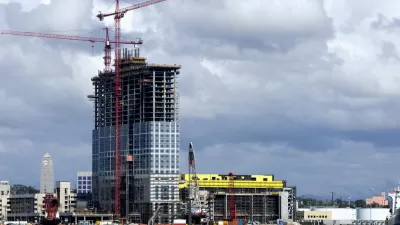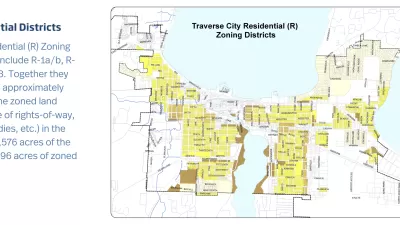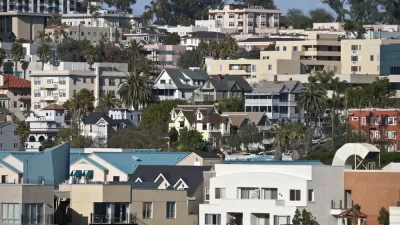A recent package of code changes by the city of San Diego will make it possible to build high-rise residential buildings and accessory dwelling units in larger areas around public transit.

The city of San Diego recently approved an ordinance that will allow high-rise apartment buildings and accessory dwelling units in a larger portion of the city by expanding the boundaries of zoning for transit oriented development from a half-mile to a mile radius around transit stations. Specifically, the expanded zoning districts will allow high-rise apartment buildings and accessory dwelling units on more parcels in the city.
David Garrick last week broke the news of the ordinance’s approval for the San Diego Union-Tribune and Globe St. also picked up the news this week. Planetizen shared news of the ordinance in January, before it went up for approval by the San Diego City Council.
Garrick’s article provides more insight into the debate that preceded the 5-4 vote that approved the ordinance. Opponents on the City Council argued that one-mile is too far to walk, and the ordinance would create congestion due to the additional car trips created by new residential density. Proponents argues that the zoning change would create opportunities for more housing affordable at low- and middle-incomes.
As noted by Garrick, the zoning changes discussed here were included in a package of 84 total municipal code changes. “The other changes include outlawing storage facilities in prime industrial areas, expanding where tasting rooms are allowed and making downtown more family-friendly with new incentives for three-bedroom apartments and child care businesses,” and “Additional changes approved Tuesday as part of the annual code update include tougher rules for new projects vulnerable to sea-level rise and stronger wildfire prevention rules for climate-friendly energy storage facilities.”
Garrick’s article, linked below, suggests that the zoning change came about as a response to pressure from state housing regulators during the Regional Housing Needs Assessment process, which has been upending planning the state of California for the past year, and will continue to do so for the foreseeable future.
FULL STORY: Badly needed homes, or ‘infill sprawl?’ City approves controversial plan for high-rises farther from transit

Study: Maui’s Plan to Convert Vacation Rentals to Long-Term Housing Could Cause Nearly $1 Billion Economic Loss
The plan would reduce visitor accommodation by 25,% resulting in 1,900 jobs lost.

North Texas Transit Leaders Tout Benefits of TOD for Growing Region
At a summit focused on transit-oriented development, policymakers discussed how North Texas’ expanded light rail system can serve as a tool for economic growth.

Using Old Oil and Gas Wells for Green Energy Storage
Penn State researchers have found that repurposing abandoned oil and gas wells for geothermal-assisted compressed-air energy storage can boost efficiency, reduce environmental risks, and support clean energy and job transitions.

Private Donations Propel Early Restoration of Palisades Playground
Los Angeles has secured over $1.3 million in private funding to restore the Pacific Palisades playground months ahead of schedule, creating a modern, accessible space that supports community healing after recent wildfires.

From Blight to Benefit: Early Results From California’s Equitable Cleanup Program
The Equitable Community Revitalization Grant (ECRG) program is reshaping brownfield redevelopment by prioritizing projects in low-income and environmental justice communities, emphasizing equity, transparency, and community benefits.

Planting Relief: Tackling Las Vegas Heat One Tree at a Time
Nevada Plants, a Las Vegas-based nonprofit, is combating the city’s extreme urban heat by giving away trees to residents in underserved neighborhoods, promoting shade, sustainability, and community health.
Urban Design for Planners 1: Software Tools
This six-course series explores essential urban design concepts using open source software and equips planners with the tools they need to participate fully in the urban design process.
Planning for Universal Design
Learn the tools for implementing Universal Design in planning regulations.
Ascent Environmental
Borough of Carlisle
Institute for Housing and Urban Development Studies (IHS)
City of Grandview
Harvard GSD Executive Education
Toledo-Lucas County Plan Commissions
Salt Lake City
NYU Wagner Graduate School of Public Service





























